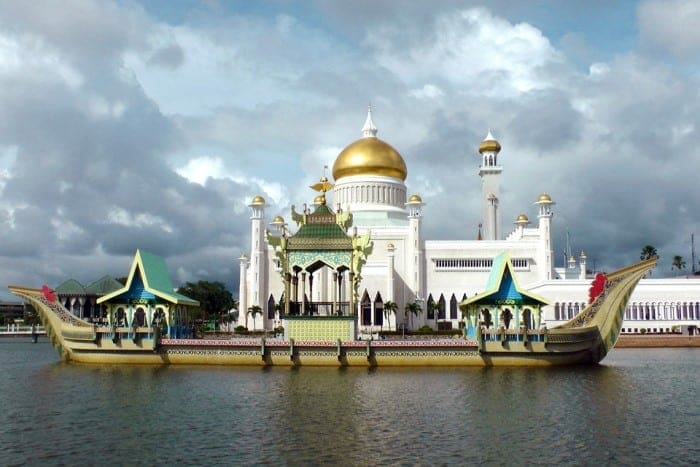Asian Currencies: The Nomad Capitalist’s Guide
February 28, 2025
As the Earth’s largest and most populous continent, Asia’s unique blend of cultures and economies offers unparalleled opportunities for exploration and capital growth.
Understanding the monetary systems of these countries is pivotal, as it provides insights into the local economies, potential for investment and day-to-day cost of living for those seeking an international lifestyle.
To assist with your research, the Nomad Capitalist team took an in-depth look at the diverse and dynamic world of Asian countries and their currencies, a subject of interest for seasoned travellers and savvy investors alike.
Before diving into our guide, it’s important to note that Asia won’t solve everyone’s problems, and you need to carefully consider whether it will work for you.
Choosing the right destination to relocate you, your family and your business to can be a complex and sometimes overwhelming challenge, depending on the location and your personal circumstances.
That’s where we come in.
Nomad Capitalist has helped over 2,000 clients move to multiple tax-friendly jurisdictions from Central America to Western Europe, Asia and further afield.
Contact us and let our team assess your personal and corporate vision and portfolio to determine the best solutions to help you retain and grow wealth, pay fewer taxes legally and acquire greater individual freedom.
Reach out to us today, and let us help you go where you’re treated best.
A Comprehensive Overview of Asian Currencies
Hosting several of the globe’s most expansive and influential economies, Asia stands out as the largest continent in the world.
Each nation on the continent has its own official currency, which influences its socio-economic context and plays a significant role in local commerce and international banking payments.
Japanese Yen

The Japanese yen, a key player on the global financial stage and the third most traded currency, holds considerable sway over the economies of Asia.
In Japanese, the word yen (円) is synonymous with ’round,’ a name inspired by the circular form of the coins.
At the end of the Edo era in 1868, Japan introduced significant changes in its banking system. Embracing a modern central bank model, the nation introduced the yen, a milestone development during the transformative period of the Meiji Restoration, which restored imperial rule to Japan.
The 10,000 yen note (worth around US$65) is the highest denomination and features Yukichi Fukuzawa, an educator and journalist of the time.
Chinese Yuan

The Chinese Yuan Renminbi (CNY) falls under the management of the People’s Bank of China. The yuan is the unit of currency, while the name of the currency itself is the renminbi.
The term ‘yuan’ has a rich history, dating back several centuries to when it was used to denote round coins. Fast-forward to the contemporary economic landscape, and the stature of the Chinese yuan has witnessed remarkable growth.
A pivotal moment in this trajectory was China’s induction into the World Trade Organisation in 2001, which propelled the yuan’s standing on the global stage.
As of February 2025, one yuan will buy 0.14 US dollars.
Indian Rupee

The South Asian powerhouse nation uses the Indian rupee as its official currency. The term rupee is derived from the Sanskrit word ‘rupya’, which means wrought silver.
Introduced by Sher Shah Suri during his reign from 1540 to 1545, the rupee has weathered various economic challenges.
Prior to 1835, the value of the currency varied from region to region until it was made uniform and later decimalised in 1955.
Indonesian Rupiah

Introduced in 1946 by the Indonesian government to replace the Japanese-controlled Dutch East Indies guilder, the rupiah has seen significant fluctuations due to the socio-political changes within the country.
The Southeast Asian archipelago state, which has a population in excess of 275 million, is the largest economy in the region.
Hong Kong Dollar

First used in 1937, the Hong Kong Monetary Authority is now the custodian of the Hong Kong dollar.
Initially, its value was tethered to the British pound, but a shift occurred in 1983, and, since then, it’s been hitched to the US dollar at a rate of 7.80 to 1, a move that has contributed significantly to its stability.
In a somewhat unique fashion – considering it’s linked specifically to the city-state – the Hong Kong dollar is virtually a tracking ‘stock’ for the city-state, which is officially a part of China.
It is also the world’s ninth most traded currency.
Singapore Dollar

Introduced in 1967, a mere two years after Singapore achieved independence from Malaysia, the Singapore dollar has seen significant growth, establishing itself as one of the most influential currencies in Southeast Asia.
The Monetary Authority of Singapore currently manages the Singapore dollar, and thanks to the country’s vigorous economy and solid banking sector, it has garnered a well-respected standing in the region.
The Singapore dollar’s Fitch Rating of AAA, denoting the lowest expectation of failure risk, is extremely rare.
Philippine Peso

The Philippine peso was introduced in 1852, making it one of the oldest in the region. Formerly known as the ‘peso fuerte’ or the ‘strong peso,’ it continues to serve as the Philippines’ official currency.
The term peso harks back to a history of over 300 years of Spanish rule in the Southeast Asian archipelago.
The currency underwent decimalisation in 1861 and has survived numerous political shifts in the country.
Vietnamese Dong

Vietnam’s currency has a fascinating history. The dong came into existence in 1978 following the union of North and South Vietnam.
With the passing years, the country’s economic turbulence and inflation necessitated multiple revaluations of the dong. Because of this, it became recognised as one of the world’s weakest currencies.
Today, the dong is still highly devalued, but economic recovery in the country could signal an upward trend.
South Korean Won

The division of Korea into North and South after World War II resulted in two separate currencies, both called the Korean won, that replaced the Korean yen.
The South Korean won, which is circulated and issued under the authority of the country’s Central Bank, is managed by the Bank of Korea.
Over the years, it has seen moderate fluctuation against the US dollar but remains a significant Asian currency, with the South Korean economy being one of the strongest and most advanced in Asia.
North Korean Won

The North Korean won is issued by the Central Bank of the Democratic People’s Republic of Korea.
The currency operates in a strictly regulated economy and is not openly traded on global forex markets due to extensive international sanctions. This situation is unlikely to change any time soon.
Foreigners are not permitted to use the currency.
New Taiwan Dollar

Taiwan’s official currency is the New Taiwan dollar, introduced in 1949 to replace the Old Taiwan dollar at a ratio of 40,000 to one.
The New Taiwan dollar has been stable over the years, largely thanks to Taiwan’s strong economic performance in the tech industry. However, this stability is threatened by growing concerns over conflict with China.
Thai Baht

In Southeast Asia, the Thai baht dates back to the 19th century and originally referred to a specific weight in gold. Today, the Bank of Thailand controls this currency, which stands out as one of the most resilient among emerging economies.
Carrying banknotes in your trouser back pocket is frowned upon in Thailand, as it implies that you are sitting on the King’s image.
Malaysian Ringgit

Malaysia’s currency, the Ringgit, has been the legal tender since 1975, replacing the Malaya and British Borneo dollar. The term Ringgit translates as ‘jagged’ in Malay and originally referred to the separated edges of Spanish silver dollars widely circulated in the area.
Brunei Dollar

Another noteworthy Southeast Asian currency is the Brunei dollar. It is interchangeable with the Singapore dollar, a unique arrangement maintained since 1967, highlighting the close ties between the two nations. The Brunei Currency and Monetary Board issues the Brunei dollar.
At current rates, one Brunei dollar buys 0.75 US dollars.
Pakistani Rupee

The Pakistani rupee was introduced after the partition of India in 1947. Tied to the British pound until 1982 to control inflation, when the arrangement was withdrawn, the Pakistani rupee was heavily devalued.
Due to how political, social and economic instability impacts the country, it remains depreciated. So much so that currently, one rupee buys 0.0036 US dollars.
Sri Lankan Rupee

Represented by the acronym LKR, the Sri Lankan rupee was first introduced in 1872, replacing the British pound at a rate of one pound to two rupees. The Central Bank of Sri Lanka now issues the rupee.
Periods of high inflation, such as when it hit an Asian record high of 61% in July 2022, serve as a reminder of the country’s potential for political and economic turmoil.
Bangladeshi Taka

Bangladesh’s currency, the taka, was introduced in 1971, replacing the Pakistani rupee at a par exchange rate when the country became independent.
Every Taka note features the same historical figure, Sheikh Mujibur Rahman, a revered political leader who helped establish democracy there but was assassinated in 1975.
Saudi Riyal

Saudi Arabia is an economic frontrunner in the Middle East. The official currency, the Saudi riyal, is governed by the Saudi Arabian Monetary Authority.
Introduced in 1925, the Saudi riyal has been pegged to the US dollar at a rate of 3.75 to 1 since 1986, lending it stability, which is also maintained by the Kingdom’s position of being the world’s second-largest producer of oil.
Turkish Lira

The lira, serving as Turkey’s currency since 1844, has seen many changes, particularly in the last two decades.
The Grand National Assembly of Turkey passed a law in 2003 that led to the removal of six zeros from the currency, giving birth to the New Turkish lira. The word ‘new’ was removed in 2009 when it reverted to the Turkish lira.
In recent times, the lira has been massively devalued against both the US dollar and the British pound.
However, while skyrocketing inflation (currently 42%), political instability and natural disasters have blighted the nation’s economy, there are signs of increasing stability.
United Arab Emirates Dirham

The United Arab Emirates dirham was introduced in 1973 by the United Arab Emirates Currency Board to replace the Bahraini dinar and the Qatar-Dubai riyal.
The UAE Dirham has been pegged to the US dollar at a rate of 3.67 to 1 since 1997 and is one of the most stable currencies in the world.
With its reliance on oil and gas revenues, pegging the dirham to the US dollar is a means of reducing the volatility of the country’s exports.
Qatari Riyal

The Qatari riyal is the currency of Qatar. This Middle Eastern nation is small but wealthy and hugely influential.
When India devalued the rupee in 1966, Qatar was one of several nearby territories to introduce its own currency.
Qatar’s vast natural gas and oil reserves have contributed to the riyal’s overall stability against the US dollar. As of February 2025, one Riyal buys 0.27 US dollars.
Bahraini Dinar

Like the Qatari riyal, the Bahraini dinar was introduced in 1966 to replace the Gulf rupee.
Renowned for its status as one of the most valuable global currencies, it is intrinsically linked to the country’s meticulously regulated financial industry.
The dinar has been pegged to the US dollar since 1980 at a rate of 1 to 2.659 – making it one of the few global currencies that is actually stronger than the greenback.
Jordanian Dinar

Jordan’s currency, the dinar, was introduced in 1949, replacing the Palestinian pound.
The Central Bank of Jordan manages the dinar and it has remained relatively stable due to the country’s prudent monetary policies.
Israeli New Shekel

The Israeli new shekel, often referred to as simply the shekel, is the official currency of Israel. The new shekel replaced the old shekel in 1985 to address rampant inflation.
The Bank of Israel manages this currency, which has proved relatively resilient in recent years despite political tensions in the region.
Kuwaiti Dinar

The Kuwaiti dinar, first introduced in 1961, serves as the official currency of Kuwait – a small nation located on the Persian Gulf that boasts considerable oil reserves.
With the Central Bank of Kuwait overseeing its management, the Kuwaiti dinar has gained recognition as one of the most robust currencies globally.
This strength is underpinned by the country’s substantial oil revenues.
Omani Rial

The Omani rial replaced the Rial Saidi at par value due to a change in the nation’s governing regime. Given Oman’s robust economy, primarily driven by oil, the rial has demonstrated considerable stability over time.
Turkmenistan Manat

The Turkmenistan manat was introduced in 1993, replacing the Russian Ruble.
The Central Bank of Turkmenistan is the issuing authority, and while the country has large natural gas reserves, the manat has experienced significant inflation.
In fact, due to soaring inflation, a new version of the currency was introduced in January 2009 at a rate of 5,000 old manats to 1 new manat.
Uzbekistani Som

The Uzbekistani som was first issued in 1993 to replace the Soviet ruble.
The currency has experienced rapid inflation in the past few years, prompting the Central Bank of the Republic of Uzbekistan to introduce higher-value banknotes.
The 200,000 som banknote (currently worth US$15.42) was introduced in July 2022 to ease cash payments.
Kazakhstani Tenge

The tenge is the official currency of Kazakhstan, the world’s largest landlocked country. Introduced in 1993, the tenge replaced the Soviet ruble at a rate of 1 tenge to 500 rubles.
Despite periods of inflation, the National Bank of Kazakhstan has taken measures to stabilise the tenge and limit currency speculation.
Kyrgyzstani Som

The Kyrgyzstani som replaced the Soviet ruble in 1993 and has maintained relative stability since then, which can be attributed to the country’s Central Bank’s strict regulations.
After the collapse of the Soviet Union, Kyrgyzstan was the second nation to introduce its own currency after Russia.
Asian Currencies: FAQs
There are roughly 50 currencies in Asia across its 48 countries and other territories.
It depends on how you define ‘best’. Regarding value against the US dollar, some of the highest-valued currencies in Asia include the Kuwaiti dinar, Bahraini dinar, Omani rial and Jordanian dinar. When referring to global recognition and usage, currencies like the Japanese yen, Chinese yuan, Indian rupee and Singapore dollar are among the top. Economic stability and performance also play a role in defining the best currencies.
The Kuwaiti dinar is often considered the highest-value currency in Asia, and even the world, in terms of its value against the US dollar. This high valuation is largely due to the country’s massive oil reserves.
India was the first nation in Asia to introduce a decimal system for their currency. This occurred in 1957 when the Indian rupee was decimalised and subdivided into 100 smaller units known as paise.
A central bank governs the management of a country’s money supply. It has various responsibilities, including managing interest rates, ensuring the stability of the financial system, issuing currency and efficiently handling the country’s foreign exchange and gold reserves.
Pegging a currency to the US dollar helps stabilise its value by linking it to the value of a more powerful currency. This can help reduce inflation, encourage foreign investment and stabilise exchange rates.
With 1 US dollar being equal to 25,536 Vietnamese dongs, the Southeast Asian nation’s currency is the third weakest in the world.
The Economic Powerhouses of Asia
Asia’s rich history, diverse economies and unique monetary systems provide a fascinating study of currencies.
From the Japanese yen and Chinese yuan to the Indian rupee and Singapore dollar, the region’s currencies reflect each country’s economic journey and aspirations on the global stage.
Given the rise of globalisation and the intricate web connecting economies worldwide, it is evident that these Asian currencies will maintain their important role in shaping the international financial landscape.
From the strength of the Kuwaiti dinar to the resilience of the Singapore dollar, the currencies of Asia offer insights into the socio-economic context of the countries they represent.
They’re not just a medium of exchange. They’re also a window into the past, present and future of these financially vibrant nations.
Become a part of the Nomad Capitalist community, where we guide you through the complexities of different economies. Contact us today so we can provide you with expert advice on maximising your wealth and help you achieve global financial freedom.



Does Puerto Rico Pay Taxes to the US?
It’s a common question and one that often fuels confusion, debate, and a fair share of misinformation – Do residents of Puerto Rico actually pay US federal taxes? When most people think of US tax obligations, they naturally assume they apply uniformly across all US citizens. But when it comes to Puerto Rico, things are […]
Read more

Zug Canton Taxes: The Ultimate Destination for Wealth Management in Switzerland
Switzerland’s global reputation is built not just on stunning views of Alpine peaks and serene lakes but also on a foundation of exceptional quality of life, world-class infrastructure and investor-friendly tax policies. The results speak for themselves: efficient public transport seamlessly links cities and villages; the standard of living regularly ranks among the highest in […]
Read more

How Smart Investors Use Venture Capital to Build Wealth
Big companies like Google, Amazon, Facebook and Apple all started out as bold ideas backed by venture capital. Decades later, the same firms are household names, as familiar to most people as electricity, the internet, or the telephone. But hindsight is a fickle friend. The truth is, it wasn’t always so obvious they’d succeed. These […]
Read more




